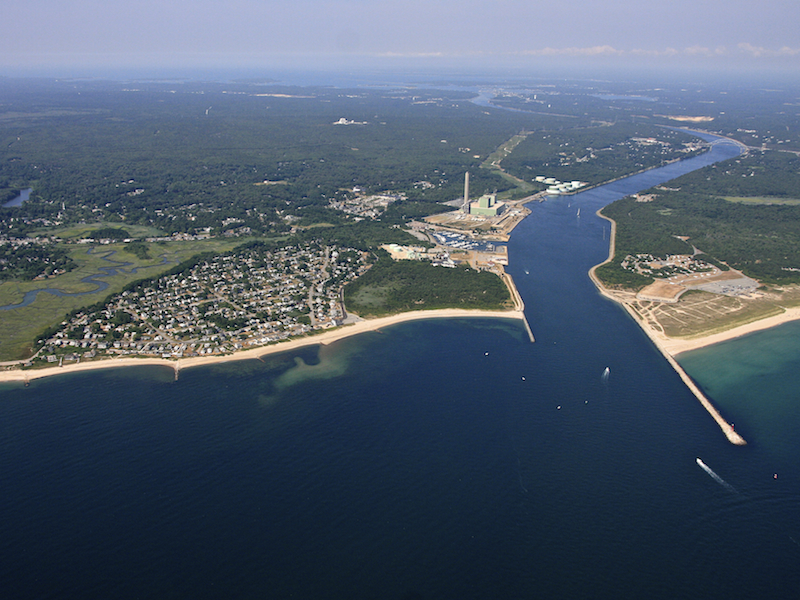The Cape Cod Canal is the widest canal in the world, and a central feature in navigation around Southeastern New England. Most people think of the canal as the sea-level “river”, otherwise known as the land cut, connecting Buzzards Bay and Cape Cod Bay. In reality the Army Corps of Engineers controls a passage that extends from Cleveland Ledge Light in Buzzards Bay to approximately 1.4 NM seaward of the canal’s eastern end breakwater light in Cape Cod Bay, a distance of approximately 15.8 NM. The land cut portion of the canal is about 6 NM in length and is the subject of this post.
You’re Being Watched
The Cape Cod Canal has a marine traffic controller on duty 24/7 in the traffic control center just east of the railroad bridge. The control center monitors the entire length of the Canal by radar, radio signals and cameras, so they know you’re there and are available to help. If you need them, call the traffic controller on VHF Channel 16 to establish contact. You will then be asked to switch to Channel 12 or 14 as the working channel to pass information. Channel 13 should be monitored at all times while transiting the Canal, but transmitting on Channel 13 should be limited to emergency situations.
Should you have an emergency in the canal like lost steering or power, ran out of fuel, etc. radio the Marine Traffic Control on Channel 13 and they will send a patrol boat to help you (no charge). If you are near the east end, near the USCG Station, then radio the USCG on Channel 16. They would likely be able to respond faster.
How Fast Can You Go?
The Coast Pilot Book and signs along the Canal specify a 10 mph (8.5 knots) speed limit over the ground. The Army Corps of Engineers cites no specific speed limits in the Canal. Instead, speed limits are measured as minimum and maximum times authorized to transit the Canal. These speed regulations must be observed by vessels of all types, including pleasure craft. For example:
Maximum Allowed Time for Passage
“Vessels of any kind unable to make a through transit of the land cut portion of the canal against a head current of 6.0 knots within a maximum time limit of 2 hours 30 minutes shall be required to obtain the assistance of a helper tug at the vessel owner’s expense or await favorable tide conditions.”
Minimum Allowed Time for Passage
The “minimum running time” (you can interpret this as maximum speed allowed) must be observed by vessels of all types, including pleasure craft. For the Land Cut portion of the canal the minimum running time authorized is as follows:
Against a foul current – 60 minutes.
With a fair current – 30 Minutes.
At slack water – 45 minutes.
You can do the math, but it boils down to a speed limit of about 10 knots through the water (as opposed to 10 knots of speed over the ground). Pleasure boats under 65’ may get some leeway in the ACOE’s interpretation of this speed limit, but if you’re throwing a big wake, or taking 3 hours to transit the ditch, you’ll probably hear about it on the radio.
The key here is “watch your wake.” The ACOE knows that many boats throw a bigger wake when not on plane, and they are not looking to write tickets. If patrols think that you are endangering other boats or visitors on the banks of the canal, you will be warned. Repeated warnings will lead to a ticket and, interestingly, a ticket from the Corps is a Federal criminal offense.
Basic Rules of the Road in the Canal
• All boats must motor through. Sails can be up.
• No stopping or anchoring or otherwise obstructing traffic in the canal.
• No fishing, trolling or lobstering from your boat.
• Vessels going with the current have the right of way.
• Vessels under 65 feet long must give way to larger vessels, and recreational boats shall not interfere with commercial vessels.
• Minimize your wake when passing moorings, boat basin facilities, and anchored maintenance work boats.
For More Information
You can contact the Cape Cod Canal Field Office at (508) 759-4431, or visit their web site at www.capecodcanal.us

I beg to differ on that claim of there being “No speed limit” in the Canal! You need to re-read the Coast pilot book, it CLEARLY states that the speed limit in the Canal is 10 Miles per hour or about 8.5 knots, this has also been broadcast over the VHF many times each day recently by Canal Control. The speed isn’t the only concern, as excessive wakes, even if obeying the 10 MPH, are also prohibited due to potential damage to the banks as well as the very real possibility of injuring someone fishing along the banks. Canal Control (USACE) can and will cite “skippers” for violations of this speed and wake limit, those tickets can get quite expensive too! Proper Seamanship techniques should ALWAYS be followed while transiting the Canal, the number 1 rule is that any vessel (even if under 65′ LOA) transiting the Canal needs to keep a radio watch on Channel 13 at all times while in the Canal, this is a REQUIREMENT that far too many boaters ignore, causing undue stress on the Canal Controllers and Patrol Boat skippers when they need to contact a vessel.
Thank you for your clarifications. The Coast Pilot Book and, in fact signs on the Canal itself, indicate a 10MPH speed limit. The ACOE itself refers to no particular speed limit in its regulations, and they read as previously posted. You are also correct that wake is the main concern. Excessive wake is the principle reason why recreational boaters are sited on the Canal passage.